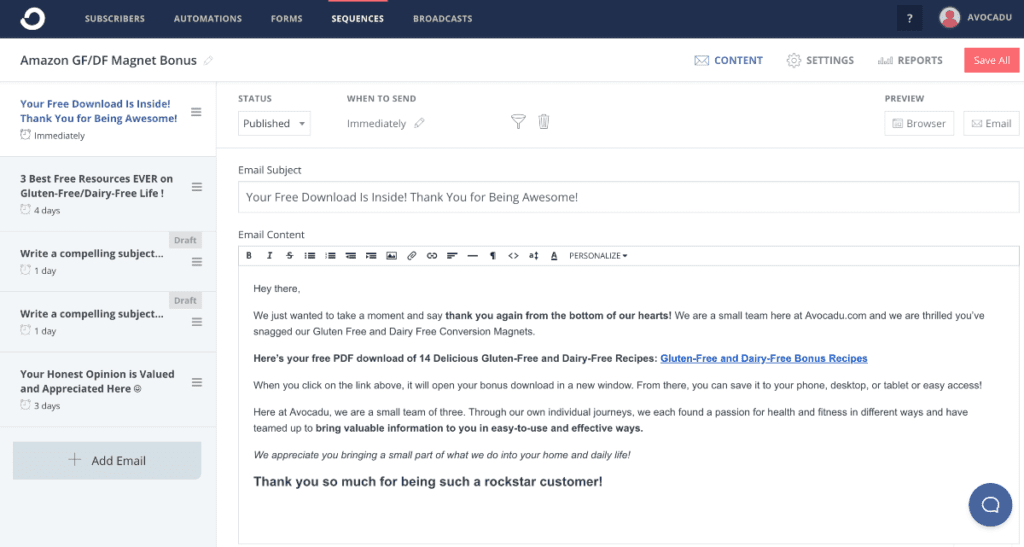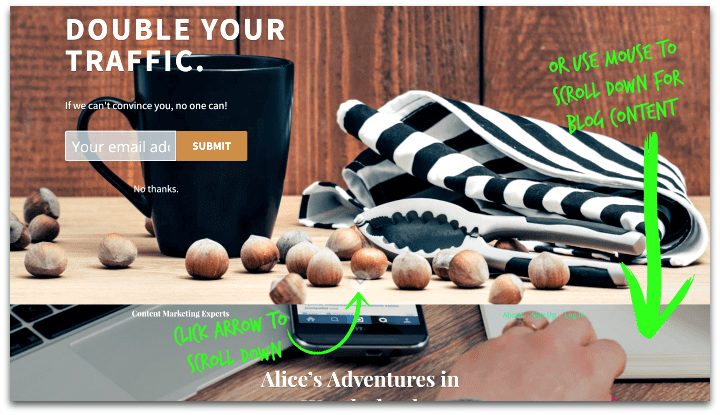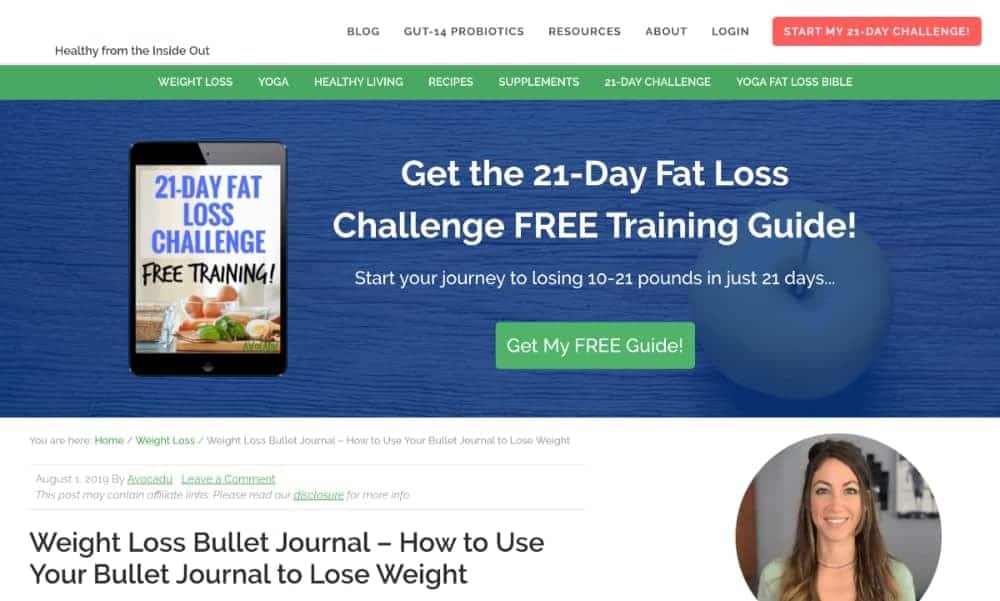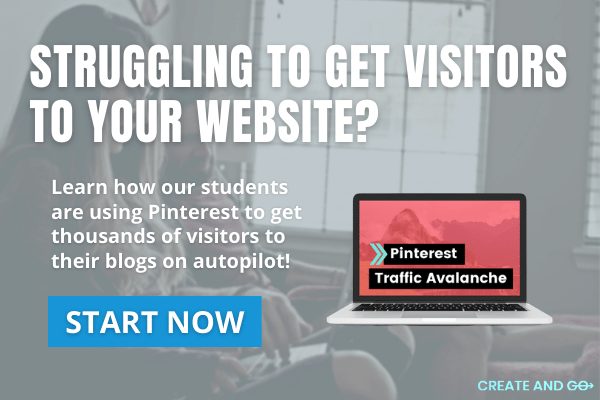How To Collect Emails From Your Blog
We partner with bada$$ companies that offer products that help our readers achieve their goals! If you purchase through our partner links, we get paid for the referral at no additional cost to you! Read our disclosure for more info.
One of the first things you hear about when you begin blogging is that you need to start collecting emails ASAP.
It's true.
Setting up a simple email opt-in form in the early stages of building your blog and collecting subscribers right away is absolutely essential.
Truth: Most of the people who visit your blog are never going to return again.
I know. It sucks. But that's how it is.
But when you turn as many of those readers into subscribers, you have a way to reach them again! With your email list…
So we need to turn as much of this traffic into leads as possible.
BUT there are absolutely some right ways and some wrong ways to do this.
Before we dive into those differences, let's chat briefly about the WHY this is necessary.
You can also check out our podcast episode on building an email list here:
Why an Email List is So Important
You will hear Alex and I say this a LOT here at Create and Go, but here it is again.
The money is in the list. No matter what you are selling, you are almost always going to sell MORE with an email list.
We actually diligently tracked our sales for months with a software called ClickMeter to confirm this:

The screenshot above shows that the majority of our sales came from our email list, not from cold sales (new readers buying straight from our articles).
Over this time period, 568 people purchased through our email list (.73% conversion rate) and 40 people purchased through our articles (.49% conversion rate).
Now, those conversion rates are terrible… I know. These were the EARLY days when we were just getting started selling our own products and we didn't really know exactly what we were doing yet.
But the point is: We still had higher sales and a higher conversion rate when selling through emails compared to cold traffic from our articles.
There are a TON reasons why email lists are so important, but here are the top 3.
Email Lists Build Trust With Your Audience
The first reason can be entirely summed up in one word: TRUST.
An email sequence gives you the time to introduce yourself to your audience and provide them with some seriously valuable and compelling content before you ask for a purchase.
This is generally called a sales funnel.
The trust that is built in this funnel is what pushes people off the fence and causes them to make that purchase.
An email list will help you sell more and sell better.
This is WHY the conversions are higher like we explained above.
An Email Lists Provides You With Customer Feedback
When we created our very first digital product on our first health and fitness blog (the one that ultimately failed), we only made ONE sale.
We spent countless hours on the program, and we only made ONE sale. It was incredibly disappointing and discouraging.
Here's what happened:
We created a product based on what we assumed our audience was interested in — not what we KNEW they wanted.
An email list provides you with the feedback to learn what content your audience is interested in, what type of product they would buy, and the ability to simply ASK them if all else fails.
This feedback is incredibly valuable throughout the stages of creating a blog through monetizing it.
It NEVER stops being valuable because it helps you continue to optimize your sales funnels and processes to better cater to your audience.
Your Email List is Your Most Valuable Asset
On our next health and wellness blog, the one that we took to six figures, we drove nearly ALL of our traffic through Pinterest.
All of our eggs are essentially in one basket, if you will.
This is a bit risky because social media algorithms change all the time.
But here's the deal, we built an email list of tens of thousands of people!
If the Pinterest headquarters were to blow up and our traffic evaporated overnight, we would have still been able to communicate with our audience and continue to make sales — through our email list.
It is an asset that you OWN and that no one can take away from you.
One of the very first investments you should make in your blog after getting blog hosting and a theme is a good email marketing service.
This is the tool that is going to help you grow your email list and build a relationship with your subscribers.
I know it's hard to make this investment in the beginning because you aren't making any money yet, but you need to shift your mindset into investment mode.
This is an investment that you are making into an asset that will HELP you make money. It's THE most valuable asset that you will have.
And yes, there are free options here, but we caution you against them if you can afford to make the small investment.
We'll talk more about free software later in this article, but you're essentially limiting yourself and your ability to maximize your efforts when building your email list due to the limitations that come with free software.
It's okay if that's all that's in your budget, but I encourage you to treat your blog like a business and consider making the small investment from the beginning.
ConvertKit
There is no better email marketing software on the internet for bloggers than ConvertKit.

We've tried just about every other email marketing software out there, including ActiveCampaign, GetResponse, AWeber, and MailChimp.
We used to switch email marketing companies faster than most people changed their underwear.
But we've now been with ConvertKit for over 3 years and haven't ever looked back.
There are a lot of reasons why we love this software, but the most important reason is the ability toedit all of your emails in ONE screen.

With every other email software that we tried, we had to navigate through multiple prompts and screens just to edit one email.
Then you would have to repeat the process all over again with the next email in your funnel.
This made it really difficult to read through your emails in sequence as part of your whole funnel.
Basically, it was harder to get the big picture — aka what you want your readers to understand from your content.
ConvertKit has saved us an insane amount of time and energy when writing our emails and also helped us create the best content possible to send to our audience.
The simplicity of ConverKit is what makes it stand out above the rest, and it was also created by a blogger, Nathan Barry, with bloggers specifically in mind.
In addition to the awesome email editor, ConvertKit also has tons of landing page designs and great forms you can embed in WordPress to collect subscribers from your blog — saving you some $$$ paying for other software to do this.
You can actually start a free ConvertKit account and create unlimited landing pages and start getting subscribers from your blog right away — for free. It also comes with the ability to send one-time broadcasts to those subscribers.
While this can be a great place to start for new creators and bloggers, we do encourage our readers and subscribers to sign up for a paid plan as soon as possible to get access to the full features of ConvertKit, which include setting up automated email sequences.
If you choose to sign up for the basic paid plan, you can also get your first month free through our affiliate link!
How to Get Subscribers on Your Blog
The main focus you should have when you're driving traffic to your blog is turning as many of those readers into subscribers as possible — using the right methods.
I say the right methods because you would never want to trick or try to force anyone into signing up for your list. They will just end up unsubscribing or unengaged with your content.
There are a few ways to get subscribers, also referred to as "collecting leads," on a blog that we will discuss in order of effectiveness with one caveat:
The last method is VERY effective and should be used in addition to one or more of the first 4 methods.
When we speak in terms of effectiveness, we don't mean with the goal of generating as many leads as possible.
There is a delicate balancing act that you must perform so as not to negatively impact the user experience too much.
The goal is to generate as many quality leads as possible in the least invasive manner for your readers.
Scroll Mats (Welcome Mats)
Scroll mats are one of the most effective ways to capture leads without upsetting your readers too much.
We personally used them on both of our blogs in the first year before we had custom banners coded into our website.
When a reader lands on your post, a screen will essentially scroll down with your opt-in on it. The reader can either opt-in or simply continue scrolling down the page to make the scroll mat disappear.
There is also usually a little arrow that the reader can click as well to make it disappear (see below).

The reason scroll mats are so effective without pissing readers off is that you don't have to play the "find the X" game.
The two best options for scroll mats are Sumo and ThriveLeads.
Sumo does have a free option though, so it's probably a better place to start for most.
Banners
This is by far our favorite option, but we didn't list it as #1 because we know that it won't be a viable option for many bloggers as they often have to be custom coded.

Banners can be custom coded into the top of your posts, and they don't take up as much real estate as scroll mats do, which provides for the best user experience for readers.
Some blog themes may allow you to do this within the theme and without additional coding, but most aren't quite that customizable.
Divi theme is the most customizable theme on the market and is probably your best option without paying a web developer to custom code banners into your site.
If you have a website designer or can code yourself, this is a really great option to capture leads and keep your website looking beautiful!
In-Text Forms
In-text forms are far less invasive to your audience but they are also less effective than scroll-mats and banners.
They are still helpful though because the people that do bother to stop and put in their email address are going to be very interested in the content.
In-text forms can be created with the help of plugins.
ConvertKit has a free plugin that you can download to add simple forms inside of your posts (requires a ConvertKit account).
They look like this:
They can (and should be) be combined WITH scroll mats or banners.
We had banners on our health and wellness blog but we also had simple opt-in forms at the bottom of our articles as well.
Pop-Ups
These work really well for some people, but it's just personally not our jam.
Pop-ups have always been very effective because they are also VERY invasive and cause people to bounce from your website completely when the "X" to exit isn't immediately visible.
Many online bloggers and marketers also suspect that pop-ups harm your search ranking with Google SEO.
This makes sense because Google doesn't want to feature pages that harm the user experience.
Ultimately, pop-ups lead to higher bounce rates and fewer people reading your blog content. The leads that you generate from them aren't worth that tradeoff.
Scroll mats and banners are far more effective and far less harmful to the user experience.
The above methods are all ways to capture leads on your blog and in your posts.
Lastly, we are going to discuss how to use landing pages to get more subscribers.
This method a little different because it requires some more in-depth discussion and you should use landing pages in addition to the above methods.
Landing Pages
Landing pages are very effective for getting email sign-ups because the whole point of the page is to sign up for your email list (not read content or take any other action).
Here is an example of one of our landing pages for Create and Go.
Landing pages are very customizable and provide you with more real estate to convince the reader to give up their email address, making them highly effective.
We link these landing pages throughout our website, in our YouTube videos, and straight from Pinterest pins.
We have two recommendations for landing page software:
- ConvertKit — Landing page templates come with a CK account and is a great option for those on a budget. You can get unlimited landing pages with both the free and paid plans.
- LeadPages — More customizable landing pages but it's an additional cost on top of ConvertKit if you go this route
We use LeadPages to create our landing pages because we like the added customizability and we use them for other purposes as well.
LeadPages also provides you with analytics that help you track how well your pages are converting as well as options to split test.
Split testing allows you to test out which designs, images, headlines, etc. are working better and help you increase your conversion rates.
Still Not Getting Enough Subscribers? 5 Possible Reasons Why
Many new bloggers take the first steps of creating a basic email opt-in form and getting their first visitors to their blog – only to have no one subscribing to their email list.
Why is this?
First, let's set up some expectations…
You aren't factoring in expected conversion rates.
A conversion rate is simply the percentage of people that take a particular action (i.e. the percentage of people that sign up for your email opt-in or the percentage of people that purchase a sale).
For example, if 100 people visit your site and 10 people opt-in to your email list, your conversion rate is 10%.
Good conversion rates to aim for:
- Landing Pages: 50%
- Above the Post Opt-Ins: 20%
- Below the Post Opt-Ins: 2%
It's important to understand what reasonable conversion rates are so that you know what to expect on your website.
Example: If you set up a basic opt-in form (described above) below your post and get 50 visitors in a day to that post, you can expect no more than a 2% conversion, which translates into a measly ONE subscriber per day.
That means that if you're only getting 20 visitors to your blog on any given day and this is your ONLY method of collecting leads, you're not likely to get even one subscriber per day.
This is why it's important to have the right expectations in place when it comes to what methods you are using to get subscribers and what the related conversion rates are.
Your content isn't good enough.
It might seem simple enough but one of the best ways to get the highest quality subscribers to your email list is to have the highest quality blog content.
I don't personally sign up for many email lists myself, but when I do… It's generally because that person WOWed me with their content.
Brian Dean, SEO expert and owner of Backlinko, is a great example. When I read his definitive guide on SEO, I searched his website for his email list and immediately signed up.
I even purchased his SEO course a few days later. His content was truly incredible and it led me to subscribe and make a purchase within days. That's powerful stuff!
Your goal should be to create the best content in your niche — so good people hang on to your every word and keep searching for more.
Related: How to Write a Blog Post Your Reader s Will Love
You don't have enough traffic to your blog.
If you think your content is BOMB and doesn't need any adjustments, the next area to consider is your traffic.
With that same 2% conversion above, 1,000 visitors still only translates into 20 subscribers.
If you're only getting 30-50 visitors a day to your blog, you are likely a new blogger that hasn't invested in any landing page software yet and are not likely to get more than one subscriber every day or two, if that.
You really need closer to at LEAST 100 visitors a day to do proper testing of opt-ins on your website, and a simple opt-in form alone will not grow your list quickly.
Opt-ins ABOVE the main post content are seen by a lot more people and greatly increase your chances of a subscriber opting in.
This is simply because a lot of people that land on your post simply don't make it all the way through your article to reach your opt-in. You'll lose most of your readers along the way as they lose interest in your article or click on other links.
As we stated above, you should aim for a conversion rate closer to 20% for above-content opt-ins. With an above-content opt-in, that same 50 readers could translate into 10 subscribers!
The bottom line is that the TYPE of opt-in that you have on your page matters.

You aren't offering a freebie (lead magnet).
The days of "Sign Up for My Newsletter!" are LONG gone.
Everybody from your favorite store to your local flower shop is trying to get you to sign up for their email list and we all get too many emails as it is.
You must ENTICE people to sign up for your email list with a free piece of content called a lead magnet (or freebie).
This can be anything from a simple downloadable checklist to a free eCourse (like our Free 5-Day Blogging Bootcamp).
This freebie should be related to one of the main topics on your blog and ideally on a subject that you might eventually offer products on.
You can use a free tool like Canva to design your freebie.
So, you spend the time to design what you think is an AWESOME freebie that anyone would be lucky to have – only to STILL have no one opting into your list…
Now what?
No one wants what you are offering.
This is never a fun place to be folks, and most of you will end up here at some point.
We sure did. Many times.
If you have designed great, professional-looking opt-ins and put them in the right places and still aren't getting any opt-ins, you have to consider this: Maybe no one wants what you're offering.
We probably tested out 15 or more "freebies" over the first year and a half of business for our health and wellness blog until we settled a couple that finally worked well.
We had everything from recipes to exercises to healthy foods. Here is a look down memory lane at some of our failed opt-ins:

The honest truth is that they just weren't good enough. No one cared enough about what we were offering to bother to opt in to our list.
Be careful about how much time you spend on your lead magnet because the last thing you want to do is spend a lot of time creating something that no one wants.
Best case scenario is that you can at least recycle the content for a post or an email.
Continue to test new lead magnets until you find one that fits really well with your audience.
Pro Tip: Consider the demographics of your audience when creating lead magnets.
We once tried to swap out our 21-Day Challenge Free Training Guide for a Free 5-Day Fat Loss Training eCourse, and it bombed hard because our audience was older and preferred written content over video content.
Read the rest of the content in this article before you decide that you think your freebie is the problem, but if you think you're doing everything else right, it is likely the problem.
You aren't testing enough.
Remember that testing is the name of the game when it comes to optimizing your opt-ins.
UNTIL you get the conversion rates you are looking for, you must continually test out new lead magnets, new types of opt-ins, different designs, etc.
Only you achieve your target conversion rates can you leave your opt-ins alone for a while and stop testing.
Software like LeadPages offers A/B split-testing of opt-ins, which can be super helpful in the process.
If you have any questions for us on email marketing or anything else we discussed in this article, please feel free to leave us a comment below!
How To Collect Emails From Your Blog
Source: https://createandgo.com/build-email-list-blog/
Posted by: childfrichis.blogspot.com

0 Response to "How To Collect Emails From Your Blog"
Post a Comment